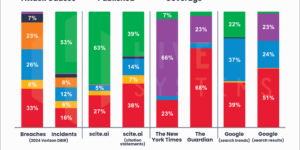The range of risks facing company executives, or directors and officers (D&Os), has increased significantly in recent years along with resulting insurance claims, according to a report published by Allianz Global Corporate & Specialty (AGCS).
 “Directors and Officers Insurance Insights 2020” highlights five mega trends that will have significant risk implications for senior management in the future:
“Directors and Officers Insurance Insights 2020” highlights five mega trends that will have significant risk implications for senior management in the future:
- More litigation coming from “bad news.” AGCS continues to see more claims against D&Os emanating from “bad news,” not necessarily related to financial reports. Scenarios include product problems, man-made disasters, environmental disasters, corruption and cyber-attacks. These types of “event-driven litigation” cases often result in significant securities or derivative claims from shareholders after the bad news causes a share price fall or a regulatory investigation.
Of the top 100 U.S. securities fraud settlements ever, 59% are event-driven, said the report. There also has been a spike in claims resulting from the #MeToo movement, where it has been alleged that D&Os allowed a toxic culture to take hold and endure within companies. AGCS said it has seen in the last year a number of securities class actions, derivative actions and regulatory investigations and fines, including from the EU’s General Data Protection Regulation (GDPR), which AGCS expects to accelerate in 2020.
- Climate change litigation on the rise. Environmental, social and governance (ESG) failings can cause brand values to plummet, said the report, noting that the social media temperature of a company is a factor examined by D&O underwriters to gauge reputational views. AGCS said, investors, regulators, governments and the public increasingly expect companies and their boards to appropriately focus on ESG issues.
As a result, climate change is one of the issues rising to the top of boards’ risk registers, and failure to disclose climate change risks may drive litigation in the coming years. Climate change cases already have been brought in at least 28 countries to date with three-quarters of those cases filed in the U.S. There are an increasing number of cases alleging that companies have failed to adjust business practices in line with changing climate conditions.
“Directors will be held responsible for how ESG issues and climate change are addressed at a corporate level,” said Shanil Williams, global head of Financial Lines at AGCS, in a statement accompanying the report. “Increasingly, they will have to consider the impact of these when looking at strategy, governance, risk management and financial reporting.”
- Growth of securities class actions globally. Securities class actions, most prevalent in the U.S. and Australia, are growing globally as legal environments evolve. AGCS said it has seen growing receptivity of governments to collective redress and class actions. “Significantly, the EU has proposed enacting a collective redress model to allow for class actions across the union, while several of its states, such as Germany, the Netherlands and the U.K., have established collective redress procedures,” said the report, noting that Canada is also an active class actions venue.
At the same time, the level of filing activity in the U.S. has been at record highs in recent years with over 400 filings in both 2017 and 2018, almost double the average number of the preceding two decades. This increased activity is affecting both U.S. and foreign companies which have securities listed in the U.S.
- Business bankruptcies on the rise. AGCS expects to see increased insolvencies which may potentially translate into D&O claims. Business insolvencies rose in 2018 by more than 10% year-on-year, due to a sharp surge of more than 60% in China, said the report. In 2019, business failures are set to rise for the third consecutive year by more than 6%, with two out of three countries poised to post higher numbers of insolvencies than in 2018.
“Political challenges, including significant elections, Brexit and trade wars, could create the need for risk planning for boards, including revisiting currency strategy, merger and acquisition (M&A) planning and supply chain and sourcing decisions based on tariffs. Poor decision-making may also result in claims from stakeholders,” added Williams.
- Litigation funding is spreading globally. All of these mega risk trends are being further fueled by litigation funding, which is now becoming a global investment class, attracting investors, hurt by years of low interest rates, who are searching for higher returns. Litigation finance reduces many of the entrance cost barriers for individuals wanting to seek compensation, but there is much debate about the remuneration model of this business, explained AGCS. Many of the largest litigation funders have set up in Europe, although the U.S. accounts for roughly 40% of the market, followed by Australia and the U.K. Other areas are opening up, such as Singapore and Hong Kong, and India and parts of the Middle East are predicted to be future hotspots.
Outlook for D&O Insurance Market
Although it is estimated around US$15 billion worth of premiums are collected annually for D&O insurance, the profitability of the sector has been challenged in recent years due to increasing competition, growth in the number of lawsuits and rising claims frequency and severity.
The loss ratio for D&O insurance has been estimated to be above 100% in numerous markets such as the U.K., U.S. and Germany since 2017, “due to drivers such as event-driven litigation, collective redress developments, regulatory investigations, pollution, higher defense costs and a general cultural shift even in civil law countries to bring more D&O claims both against individuals and the company in relation to securities.”
AGCS said it has seen double digit growth in the number of claims it has received over the past five years.
Insurers are facing more legal costs as attorney activity from plaintiffs requires more claims handling, as well as more settlements and claims, said the report. “Another issue has been that event-driven litigation results in aggregation issues where multiple policies may be triggered by an event. For example, one event could trigger both D&O and either aviation, environmental, construction, product recall or cyber claims,” it added.
Source: Allianz Global Corporate & Specialty (AGCS)
*This story ran previously in our sister publication Insurance Journal.




















 Carrier Management’s 2024 Top Features (Reader’s Picks Unlocked)
Carrier Management’s 2024 Top Features (Reader’s Picks Unlocked)  Slideshow: Carrier Management’s 2024 Top Editor’s Picks (Unlocked)
Slideshow: Carrier Management’s 2024 Top Editor’s Picks (Unlocked)  Weak La Nina Expected in the Central Region of the U.S. This Winter: NWS
Weak La Nina Expected in the Central Region of the U.S. This Winter: NWS  Dear Elon and Vivek: Insurance Commissioners Urge DOGE to Ditch FIO
Dear Elon and Vivek: Insurance Commissioners Urge DOGE to Ditch FIO 




